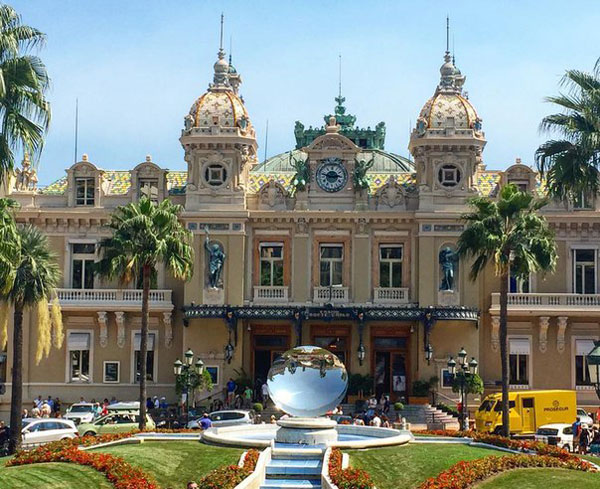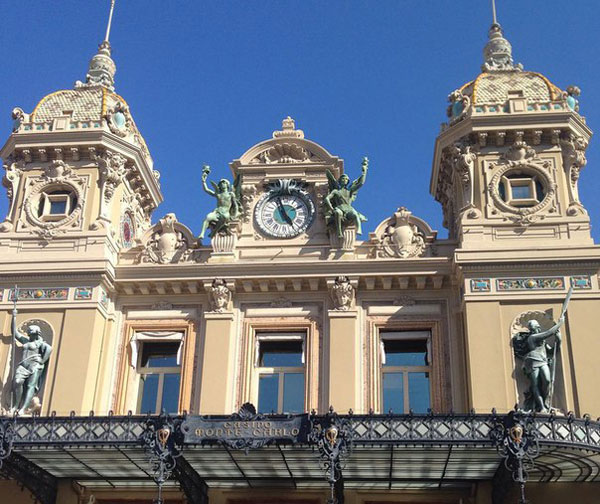Officially named "Casino de Monte-Carlo", the Monte Carlo Casino is a gambling and entertainment complex located in Monaco. It includes a casino, the Grand Théâtre de Monte Carlo, and the office of Les Ballets de Monte Carlo.
The Casino de Monte-Carlo is owned and operated by the Société des bains de mer de Monaco, a public company in which the Monaco government and the ruling family have a majority interest. The company also owns the principal hotels, sports clubs, foodservice establishments, and nightclubs throughout Monaco.
History
The idea of opening a gambling casino in Monaco belongs to Princess Caroline, a shrewd, business-minded spouse of Prince Florestan I. Revenues from the proposed venture were supposed to save the House of Grimaldi from bankruptcy. The ruling family's persistent financial problems became especially acute after the loss of tax revenue from two breakaway towns, Menton and Roquebrune, which declared independence from Monaco in 1848 and refused to pay taxes on olive oil and fruit imposed by the Grimaldis.
In 1854, Charles, Florestan's son and future Prince of Monaco, recruited a team of Frenchmen—writer Albert Aubert and businessman Napoleon Langlois—to devise a development plan and write a prospectus to attract 4 million francs needed to build a spa for the treatment of various diseases, a gambling casino modeled from the Bad Homburg casino, and English-styled villas. Granted the concession of 30 years to operate a bathing establishment and gaming tables, Aubert and Langlois opened the first casino at 14 December 1856 in Villa Bellevu. Intended to be only a temporary location, the building was a modest mansion in La Condamine.
In the late 1850s, Monaco was an unlikely place for a resort to succeed. The lack of roads needed to connect Monaco to Nice and the rest of Europe, and the absence of comfortable accommodations for visitors, as well as the concessionaires' failure to publicize the new resort, resulted in far fewer customers than was originally anticipated. Unable to raise the capital needed to operate the money-losing enterprise, Aubert and Langlois ceded their rights to Frossard de Lilbonne, who in turn passed it to Pierre Auguste Daval in 1857.[3]
Seaside facade before 1878
During this initial period, the casino had been moved several times, until it finally ended up in the area called Les Spelugues (English: The Caves). Construction at this site began on 13 May 1858 to designs of the Parisian architect Gobineau de la Bretonnerie and was completed in 1863. Gobineau de la Bretonnerie also designed the neighboring Hôtel de Paris (constructed in 1862).
Although the casino began to make a profit in 1859, Daval was not up to the task. Just like his predecessors, he was incompetent and lacked the ability to bring the gambling enterprise to the scale envisioned by Princess Caroline. Frustrated, she dispatched her private secretary M. Eyneaud to Germany, hoping to recruit François Blanc, a French entrepreneur and operator of the Bad Homburg casino. Blanc declined the offer. It took a lot of time and persuasion on the part of Princess Caroline to convince the Blancs to move to Monaco. Princess Caroline even appealed to Madame Blanc, whom she befriended during her first visit to Bad Homburg, with a suggestion that Monaco's mild climate would be good for Madame Blanc's ill health.
General plan by Garnier and Dutrou, 1879
Facade on the Place du Casino after the expansion of 1878–79
Finally, in 1863 François Blanc agreed to take over Monaco's casino business. To manage the new venture, a company—the Societe des Bains de Mer et du Cercle des Etrangers—was formed with capital of 15 million francs. Among the prominent investors were Charles-Bonaventure-François Theuret, Bishop of Monaco, and Cardinal Pecci, the future Pope Leo XIII. Blanc became the single majority stockholder in the company and received a 50-year concession, which would last until 1913. Blanc used his connections to quickly raise the required capital, and began the massive construction. On Blanc's insistence, the Spelugues area where the gambling complex was located was renamed to make it sound more attractive to casino visitors. A few suggestions were considered, and the name Monte Carlo was chosen in Prince Charles' honor.
In 1878–79, the casino building was transformed and expanded to designs of Jules Dutrou (1819–1885) and Charles Garnier, the architect who had designed the Paris opera house now known as the Palais Garnier. François Blanc knew Garnier, because Blanc had provided a loan of at least 4.9 million gold francs to the cash-strapped government of the French Third Republic, so that the opera house, which had been started in 1861, could be completed. It had finally opened in 1875. The alterations to the Casino de Monte Carlo included the addition of a concert hall (designed by Garnier and later named the Salle Garnier), located on the side of the casino facing the sea, and the redesign and expansion of the gaming rooms and public spaces, mostly carried out by Dutrou on the side of the casino facing the Place du Casino, where the Hôtel de Paris Monte-Carlo and the Café de Paris were also located.
Eastern elevation (c. 1878–80) of the Trente-Quarante Gaming Room with the theatre to the left and behind
In 1880–81, the casino was expanded again, to the east of Dutrou's Moorish Room, by the addition of the Trente-et-Quarante Gaming Room, also designed by Garnier. Subsequent additions and expansions, and the remodeling of the Trente-et-Quarante Gaming Room into the Salle des Américains, have mostly obliterated Garnier's contributions to this part of the casino, except for some ceiling decorations. In 1898–99 the Salle Garnier was remodeled by architect Henri Schmit, primarily in the stage area, so that it would be more suitable for opera and ballet performances. However, much of Garnier's original facade and the interior design of the auditorium itself remain intact. Despite all of the later additions and modifications, the casino still has a distinctly Beaux Arts style.
In 1921, the first Women’s Olympiad was held at the Casino gardens.
Until recently, the Casino de Monte-Carlo has been the primary source of income for the House of Grimaldi and the Monaco economy.











